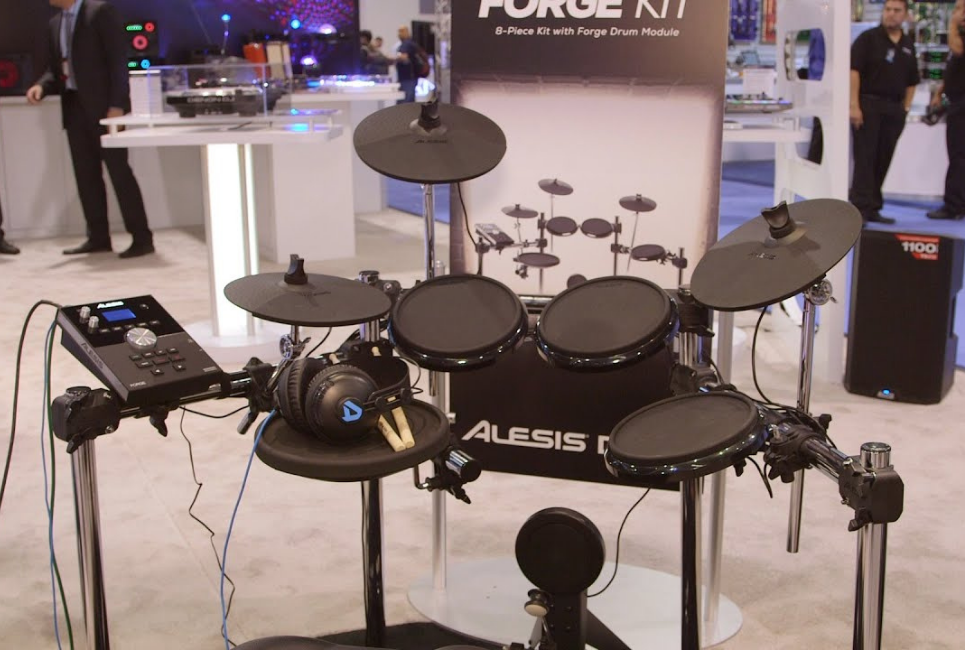Alesis has made a few top-quality electronic kits over the years. The brand specializes in making affordable kits that cater to a wide market of beginner and intermediate drummers. My first suggestion to anyone looking for a cheap electronic kit is to check out all the Alesis ones.
The Alesis Forge was one of those popular kits a few years back. It’s since been discontinued, but you can still find it being sold by music stores that have it in stock or on secondhand marketplaces. If you see one of these kits up for sale, you should know how it ranks among all the current available drum sets. That’s what this review is for.
Why the Alesis Forge is Outdated
It’s the natural order of things for a drum brand to discontinue a product once they have surpassed it completely with their later models. That’s what happened to the Alesis Forge. The biggest reason this kit isn’t being made anymore is the rubber drum pads.
Nowadays, most Alesis kits have superior mesh pads. The only one that doesn’t is the Burst kit which is the bottom-line model from Alesis. The Forge was competing with the slightly higher-priced models. Since it doesn’t have mesh drum pads, the other models would always be preferred by buyers. So, Alesis stopped producing these kits.
Alesis Forge Review
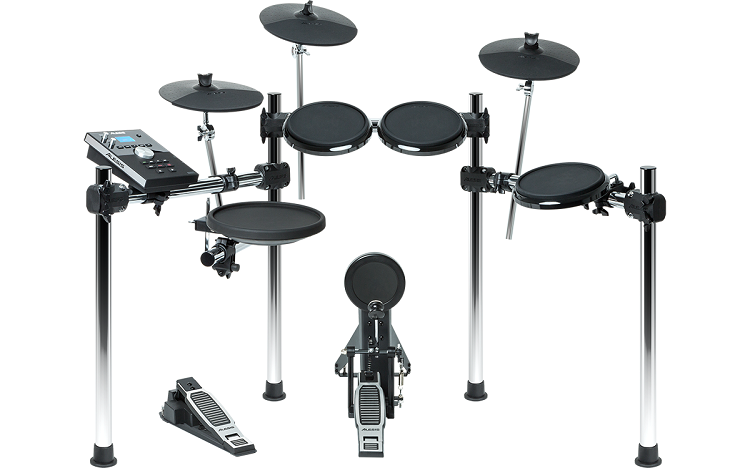
If you manage to find one of these kits being sold somewhere, read on before making the decision to buy it. Here is a modern-day review of the Alesis Forge.
Pads
The pads of Forge are its biggest downfall in the modern drum market. You get hard rubber pads all around the kit. Although they’re made of rubber, they’re surprisingly responsive and reactive to different dynamic playing. They’re just don’t feel as responsive or personal as mesh pads do.
Here are the exact specifications of all the pads:
- 11” dual-zone snare
- Three 8” tom pads
- 3 cymbal pads
- 10” hi-hat pad
- 10” crash pad
- 10” ride pad
There isn’t anything particularly impressive about these pads regarding their sizes. The crash and ride pads are chokeable, but you can’t play their bells to get a different sound.
The one pad that I am impressed by with the Forge is the kick pad. It’s mounted to a sturdy tower, and the kit ideally comes with a kick drum pedal to match. If you’re buying the set secondhand, you may not get the pedal. So, just look out for that.
Module
The Forge drum module is fairly extensive. It has over 600 sample sounds to play around with and 50 preset drum kits. You get 20 slots to create your own kits. The module allows you to load your own samples via a USB, giving a good sense of customization to the kit.
The module also has 60 play-along tracks that cover a wide array of musical styles. These tracks are fairly standard with all Alesis kits, but it’s great to know that they’re here as well.
You can record yourself playing to these tracks to listen back and see how you sound. That feature may not sound like much, but I’ve found that listening to yourself play is the fastest way to improve. So, the playback feature is golden in my eyes.
Although the module seems fairly good, it has all the same features and sounds like the other Alesis modules that are currently available. So, there’s nothing special about it that sets it apart.
Price
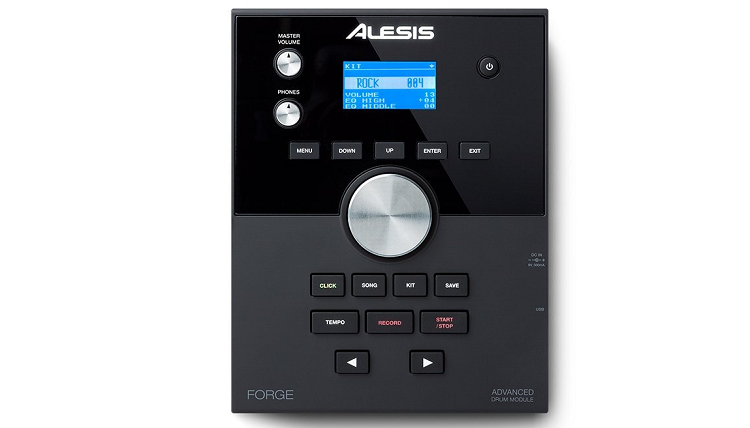
Here is where things will vary the most. When the Forge was still on the market, it cost around $500 to buy new. You may find some music stores selling it for a similar price. They may even sell it for a higher price due to inflation.
However, you could easily find someone selling one of these kits secondhand for much lower. I wouldn’t recommend buying an Alesis Forge kit at full price as you can get more recent kits for about the same cost.
The Forge used to be a strong contender due to its low price, but it’s since lost that title as more reasonably priced models have come out. Electronic drum sets are somehow getting cheaper and more accessible as the years go by, thanks to the technology evolving. Here’s a clear example of that.
Longevity
Something to strongly consider when buying an electronic kit is the fact that things may go wrong in the design. This is the case with all electronics. An acoustic drum will never not work, but an electronic drum pad may stop working for some unknown reason. This is where customer support from the brand comes in.
I have a few friends with electronic kits that have malfunctioned. They contacted the brand and got their issues sorted fairly quickly. Since the Alesis Forge is a discontinued product, you’re not going to easily get that kind of support from Alesis.
They may help you troubleshoot a few things, but they won’t be able to send you parts that aren’t in production anymore. So, this kit isn’t going to last long if things go wrong with the design.
Pros
- Affordable drum set, especially when buying secondhand
- Sturdy kick drum tower
- Strong drum module
- Decent response from all the pads
Cons
- Discontinued product, so not easy to find
- The pads are all rubber and not mesh
Final Verdict
At the end of the day, I’d only recommend getting this kit if you find it being sold for a very low price. It would be unwise to buy it new as you can get an electronic drum kit with updated technology on the module and higher-quality pads.
The Alesis Forge served many drummers fairly well in its time, but Alesis has moved on to bigger and better things as the years have gone by. With that being said, let’s have a look at a few current electronic drum kits that I would happily recommend.
5 Current Alternate Options That Are Better
Alesis Debut
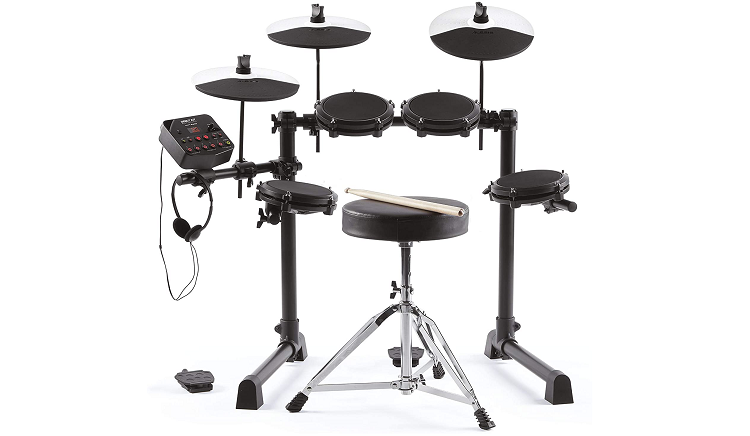
The Alesis Debut is the prime entry-level kit from Alesis. It’s one of their most affordable drum sets, and it’s typically aimed at beginner kids who are looking to play drums. The reason I say it’s a good set for kids is that the pads can’t be raised high enough for tall people, making it not ideal for adults.
The most impressive thing about the Debut is the mesh-head pads. Even though the kit is simple and affordable, it has a full set of mesh pads that can be tuned to different tensions. Here lies a perfect example of how the modern kits from Alesis are superior to the Forge kit.
The Debut drum module has 10 preset drum kits with 120 onboard sample sounds. It’s simple, yet extensive enough to keep someone entertained for a good while.
If you’re looking for an electronic kit for a child to start learning the drums, the Alesis Debut is my recommended option.
The only big issue here is that the bass drum is controlled by a foot trigger instead of having a pad and pedal. This isn’t ideal as it doesn’t resemble how a bass drum would feel on an acoustic set.
Pros
- Fantastic kit for children
- Very affordable
- Full set of mesh pads
Cons
- Not a good option for adults
- Bass drum is a trigger pedal and not a kick pad
Alesis Nitro Mesh

The Nitro Mesh is one of Alesis’ best-selling drum sets. It’s the king of entry-level electronic kits as it caters to every age and body type. It costs just under $400, making it a very attractive option for anyone looking for a kit.
The tunable mesh heads are incredibly responsive, and they feel great to play on. One of my friends owns one of these kits, and he tunes each pad a bit looser as you go down the toms. This gives it a similar feeling to playing down an acoustic kit, which I love.
The drum module has 40 preset drum kits with 385 onboard sounds to create a few of your own kits with. You also get the same 60 play-along tracks that were offered on the Alesis Forge drum module.
I’d say the Alesis Nitro Mesh is the direct competitor to the Alesis Forge. It does all the same things but costs a bit less, making it a better option in every aspect. It caters more to beginners, though. More experienced drummers will find the kit lacking a few vital features.
We have a full review here on the Alesis Nitro Mesh if you want to see more details on what it offers.
Pros
- One of the most popular kits from Alesis
- Full set of mesh heads
- Best entry-level electronic kit on the market
Cons
- Not ideal more experienced drummers
Alesis Surge

The Alesis Surge has a similar price to what the Alesis Forge had, making it another worthy competitor. If you’re happy to pay a bit more, then I would recommend getting this kit rather than the Nitro Mesh.
The benefit of the Surge is that it has larger pads with a sturdier rack holding everything together. The chrome rack will be the first thing that everyone notices. It’s similar to the chrome rack that the Forge had. However, I found it to be a bit stronger and more customizable.
The pads all have two zones, allowing you to play sounds on the surfaces and on the rims. The cymbal pads are mostly the same as the previous kits.
The Surge Module has 24 preset drum kits with 16 slots to make your own from the 385 available sounds. You also get the same 60 Alesis play-along tracks.
Pros
- Relatively large dual-zone mesh pads
- Sturdy chrome rack
- Better option for experienced players than the Nitro Mesh
Cons
- Kick drum trigger is known to be mildly problematic
Roland TD-1K
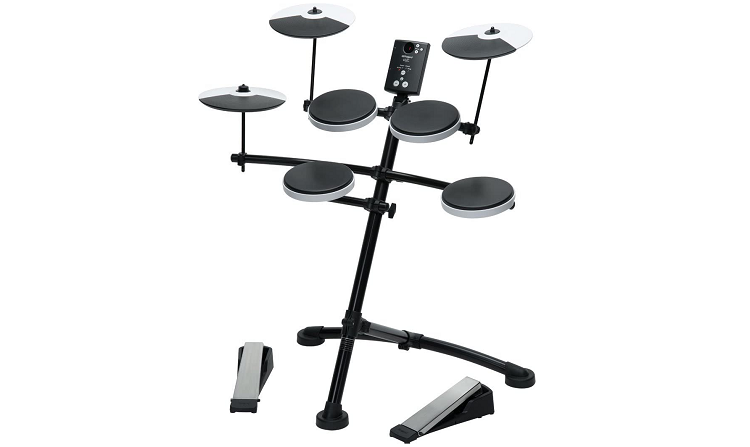
The Roland TD-1K has a similar price to the Alesis Surge. You may be wondering why I’m recommending it then as it looks like a much lower-quality kit. The biggest reason I’ve put this kit here is because of the sound quality.
Roland kits have much better sample sounds than Alesis kits do. Roland is the top-dog electronic drum kit brand, so all the kits are known to have excellent sound quality. I know many drummers who detest the sound of electronic drums, so getting a relatively affordable kit with higher-quality sounds may be the answer to keeping drummers like that happy.
This kit is a closer competitor to the Alesis Debut. It also only has a kick drum trigger pedal, and the pads are unfortunately rubber and not mesh. However, the kit feels great and sounds fantastic, making it a worthy option to consider.
Pros
- Amazing sound quality
- Very responsive pads
- Cheapest electronic drum set from Roland
Cons
- Pads are rubber and not mesh
- Has a kick trigger pedal instead of a pad
Yamaha DTX402K

The DTX402K is the option from Yamaha that sits in the same price range as all the other kits that I’ve mentioned. The benefit of Yamaha electronic drums is that they use sampled sounds from Yamaha’s pristine line of acoustic drum sets.
There’s an argument that Yamaha’s drum module sounds are far more authentic than the other brands. Whether you agree with that or not, this kit is a viable option to consider.
Included is the DTX402 drum module, which has 10 preset kits, a few play-along tunes, a metronome, training modes, and a volume control knob. The beauty of this module comes in its simplicity. There’s no menu scrolling here as all the features are laid out as buttons to press.
All the pads are rubber pads, and the kit also has a kick trigger instead of a pad. It’s another competing kit to the Alesis Debut and Roland TD-1K.
Pros
- Authentic Yamaha sounds
- Drum module is incredibly simple and easy to navigate
- Connects to a Yamaha app, adding a few more nifty features
Cons
- Rubber pads
- Has a kick trigger instead of a kick pad
Roland TD-07DMK
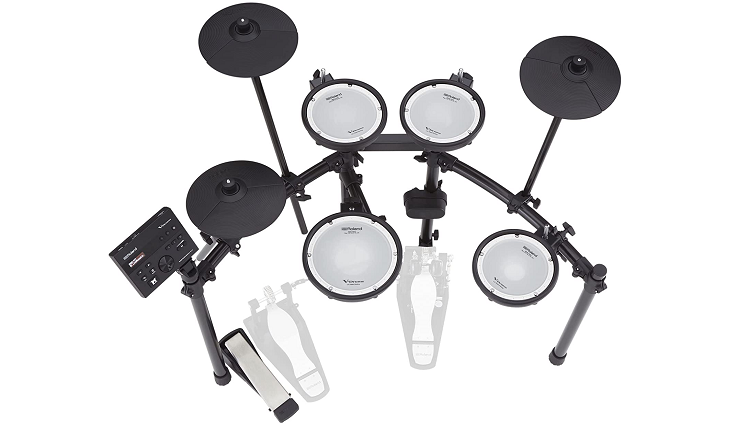
The Roland TD-07DMK is one of the best electronic kits under $1000 at the moment. While it’s a bit pricier than the previous kits, I’d highly recommend saving to get this kit instead. It has higher resale value, better customer support, and overall, it just feels like a superior kit to all the previous ones.
The drum module is the most impressive part of the kit. When you pay over $500 for an e-kit, you’ll start seeing some new features on the drum modules. This module has 25 preset kits with space for 25 custom kits. The module has 30 sound effects for you to customize your kits with.
While the kick pad isn’t supported on its own tower, it feels quite sturdy and can even support a double pedal.
My favorite thing about this kit is how all the cymbal pads are mounted onto a swiveling ball mechanism. It allows you to position each pad in any way you could possibly think of.
This kit is my top pick for this list. If you’re able to get it, you won’t be disappointed with it.
Pros
- Highest-quality kit on this list
- Extensive features on the drum module
- Extended adjustability on the cymbal pads
- Pads for great to play on
Cons
- More expensive than any of the previous recommended electronic drum sets
FAQ
Answer: Technology is constantly evolving, so the features on older kits tend to become outdated after a few years. This is one of the biggest differences between acoustic and electronic drum sets. You can still easily find an acoustic kit introduced in 2001, whereas an electronic kit from that time will be near impossible to find.
As an electronic drum company sells higher-quality kits at more competitive prices, their older kits stop performing well on the market. So, the kits get discontinued as they stop being bought as frequently by customers, and the profits of the kit decline.
Answer: You can easily use electronic kits for performances. However, I’d only advise using a high-quality electronic kit in a professional setting. While entry-level e-kits are usable for practicing purposes, they don’t sound near as good as an acoustic kit would in a live setting.
The only kit from the above list that I would happily use in a professional live gig would be the Roland TD-07DMK. Even that would only be passable. So, while it’s possible to easily use an electronic kit for live performances, it will always be more ideal to use an acoustic set. You can get away with using cheaper acoustic sets as well.
Answer: This depends on your budget and what you want to use the kit for. If you’re getting a kit for a child who’s interested in playing the drums, an affordable $250 electronic kit will be perfectly suitable.
If you want a moderately decent electronic set that you can practice with and that feels resemblant to an acoustic set, you can expect to pay between $300 and $1000. The higher-priced kits are naturally better in quality.
Anything over $1000 would be considered a pristine electronic kit. The Alesis Strike is the top kit from Alesis, and it costs well over $2000. Some of the top-quality Roland sets cost as much as $8000.
Answer: Most electronic drum modules have a USB port that you can connect a MIDI cable to, allowing you to run the kit through a computer. You’d need to have a DAW (Digital Audio Workstation) installed to detect the MIDI signals coming from the module.
The cool thing about doing this is that you can record your electronic drums. You can also run a VST to get better-quality drum sounds. Connecting your drum module to a computer opens up a whole world of possibilities.
This is the best way of taking a cheap kit like the Alesis Nitro Mesh and playing professional-quality sounds with it.
Conclusion
At the end of the day, the Alesis Forge isn’t a kit that you should put too much effort into researching. You’ll find it quite difficult to actually find one being sold, and you should only buy it if you can get it for a steal of a price.
It’s better to put your money into a current electronic kit that offers more bang for your buck. Check out all the kits I listed in the alternate options section and choose between one of those. That path will provide you with a better kit that you’ll be happy with playing on.
For more interesting reading on drum gear, check out the following articles:
